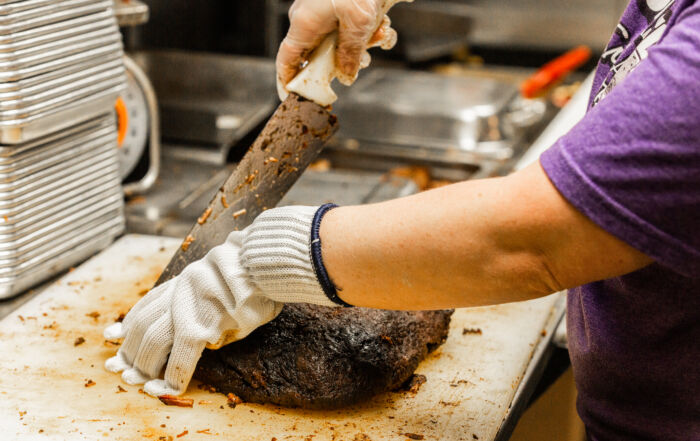A Date with Safe Food Labels
When it comes to food, calendar dates relating to time and temperature are important and sometimes confusing. Terms we use are: 1) food product or code dating used for commercial food manufacturing and 2) date marking used for food prepared onsite in a restaurant. In a restaurant at the receiving step or the retail food store as a consumer, “Sell by July 14” is a type of information you might find on a meat or poultry product. Are dates required on food products? Does it mean the product will be unsafe to use after that date? Here is some background information, which answers these and other questions about food product dating.

What is Food Product Dating? “Open Dating” (use of a calendar date as opposed to a code) on a food product is a date stamped on a product’s package to help the store determine how long to display the product for sale. It can also help the purchaser to know the time limit to purchase or use the product at its best quality. It is not a safety date.
Is Dating Required by Federal Law? Except for infant formula and some baby food, product dating is not required by Federal regulations. However, if a calendar date is used, it must express both the month and day of the month (and the year, in the case of shelf-stable and frozen products). If a calendar date is shown, immediately adjacent to the date must be a phrase explaining the meaning of that date such as “sell by” or “use before.”
Believe it or not, there is no uniform or universally accepted system used for food dating in the United States. Although dating of some foods is required by more than 20 states, there are areas of the country where much of the food supply has some type of open date and other areas where almost no food is dated.
What Types of Food Are Dated? Open dating is found primarily on perishable foods such as meat, poultry, eggs and dairy products. “Closed” or “coded” dating might appear on shelf-stable products such as cans and boxes of food. In the food service environment, always look for the dates on our perishable foods on the outside of the case at the receiving step.
Types of Dates:
• A “Sell-By” date tells the retail store how long to display the product for sale. Consumers should buy the product before the date expires.
• A “Best if Used By (or Before)” date is recommended for best flavor or quality. It is not a purchase or safety date.
• A “Use-By” date is the last date recommended for the use of the product while at peak quality. The date has been determined by the manufacturer of the product.
• “Closed or coded dates” are packing numbers for use by the manufacturer.
“Date Marking” in the FDA Food Code & Listeria — At the restaurant level for on-premise preparation, there are specific requirements for re-labeling perishable foods, once the package is opened or ready-to-eat foods are prepared onsite. Date marking is required to control the growth of bacteria called Listeria monocytogenes that grows at refrigerated temperatures. Listeriosis (the disease) can be a very serious infection to any immune compromised persons (elderly, pregnant women, children, or infants) and can cause fatalities. Do a search for more on Listeria. Since it will grow at below 41F, the main measure to keep Listeria under control is TIME, not temperature. The Food Code has expanded on date marking in the past few years to help control Listeria, so we will have more to come on this subject.
Who must use “Date Marking”? All retail food facilities must follow the date marking regulations, including restaurants, grocery stores, hospitals, schools, eldercare facilities, and any facility selling or serving food directly to the consumer.
What Foods Must be Date Marked? – 1) Refrigerated ready-to-eat (RTE) potentially hazardous foods that are prepared and held in a food facility for more than 24 hours. 2) Refrigerated RTE potentially hazardous foods that are prepared and packed by a food processing facility and opened in a foodservice facility and held for 24 hours or longer.
How do we Date Mark? The 7 Day Rule — There are more details and some exemptions to date marking, but this is the basic guideline. You design your date mark system in your written food safety HACCP plan, so it’s clear to employees and the regulatory authority. You can use the actual date consumed, sold, or discarded on the container, colored labels, dots, or other similar systems. Whatever marking you choose, stick to it. The 7 day rule covers these items:
1. Foods prepared in foodservice must be held at 41F or below and marked with the day or date by which the food shall be consumed on the premise, sold, or discarded for a maximum of 7 days. The day of preparation is Day 1.
2. Foods from a processing plant must be held at 41 F or below and marked at the time their original container is opened. The date of opening is Day 1. Additionally, the day or date marked by the food facility cannot exceed the manufacturer’s use-by date IF the manufacturers use-by date is based on food safety rather than just food quality. Check with your food manufacturer if uncertain.
3. Foods that may be combined or mixed together must retain the date marking of the earliest prepared or first prepared ingredient. Example: if you use day old fried chicken (properly refrigerated) to make todays chicken salad, you must subtract a day from your date mark on the chicken salad.
Bottom Line: When in Doubt, Throw it Out — Foods can develop an off odor, flavor or appearance due to spoilage bacteria. If a food has developed those characteristics, it should be obvious in a restaurant setting, do not use it for quality reasons. If foods are mishandled, foodborne bacteria can grow and cause foodborne illness — before or after the date on the package. If perishable food is in the “danger zone” (above 41° F or below 135° F), for four hours or more, discard it. For example, if sliced deli meats or prepared cold sandwiches with perishable ingredients are taken are taken to a catering event and left out un-refrigerated for several hours, they wouldn’t be safe if used thereafter, even if the date hasn’t expired.
***
About the Author: Lacie Thrall

READ MORE POSTS
The Second Wave: Food Safety Myths That Deserve Your Attention
Walk into any commercial kitchen, and you'll find hardworking staff following protocols they have learned [...]
What Your Staff Gets Wrong About Food Safety (And How to Fix It)
Earlier this month, I was mindlessly scrolling through Facebook when I came across a post [...]
Your Guide to Approved Food Safety Training Programs in 2025
Early in my foodservice career, I persuaded the owners of the restaurants I managed to [...]
Thanksgiving Food Safety: Separating Fact from Fiction
Most blogs that I write are geared toward the foodservice professional preparing food in commercial [...]










